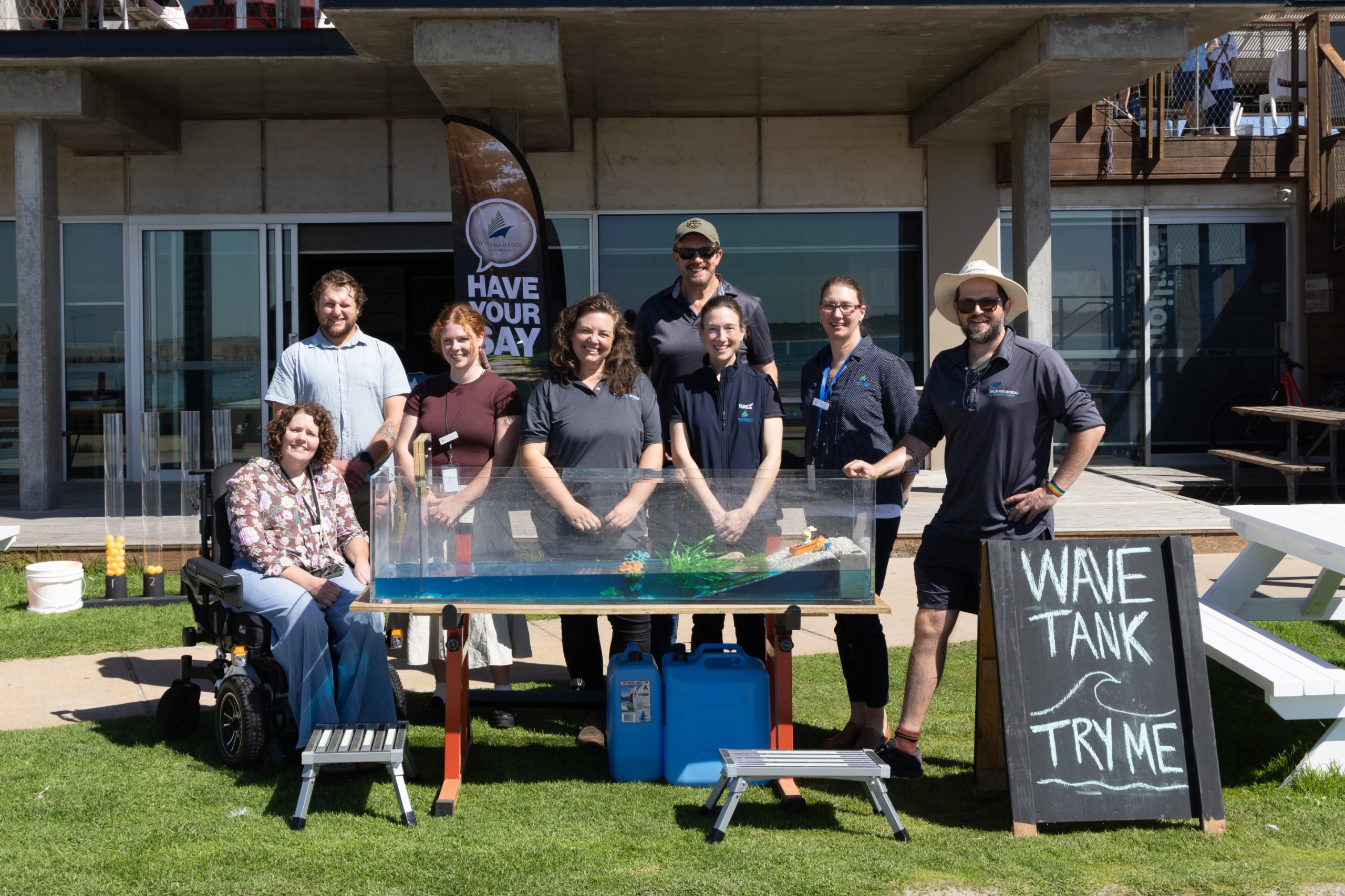Page Navigation: Engagement Summary | Values & Connection | Knowledge & Concern |Issues & Opportunities | Community Aspirations | Feedback on Engagement | Next Steps
RCAP Stage 2 Engagement Report
Together with Traditional Owners and partner agencies, we are developing a Regional Coastal Adaptation Plan (RCAP) and are currently completing Stage 2 – Vision, Values and Objectives of the project.
 The final Regional Coastal Adaptation Plan will be a resource for land managers to make better decisions about coastal hazards and adaptation, and it will also provide clarity and transparency to the community and key stakeholders about the approach we are taking as land managers.
The final Regional Coastal Adaptation Plan will be a resource for land managers to make better decisions about coastal hazards and adaptation, and it will also provide clarity and transparency to the community and key stakeholders about the approach we are taking as land managers.
The final Regional Coastal Adaptation Plan will help us work towards a more resilient coast and sustainable future, by stepping out how plan to adapt to the impacts of climate change such as increased coastal hazards, severe weather events and rising sea levels.
This engagement summary presents a snapshot of what we heard at Stage 2 from our Looking Forward Community Engagement which ran late November 2024 to April 2025, and includes insights, concerns, and aspirations from 1000+ people who engaged with us from Warrnambool to Torquay.
Insights and information gathered through this stage of engagement will lead the development of a shared vision and objectives for coastal hazard risk management and adaptation. This will be captured in the subsequent RCAP Stage 2 Project Report and shared on the Looking Forward Have Your Say webpage.
The summary of community values, aspirations, and perspectives captured here will also directly inform current and subsequent stages of the Regional Coastal Adaptation Planning project as well as other site specific coastal adaptation projects and our ongoing coastal management related decision making.
Engagement Summary
Spanning six months and five local government areas, our Stage 2 community engagement was one of our largest and longest engagement campaigns.
It had the dual purpose of educating and informing community and key stakeholders on our approach to coastal hazard management and adaptation planning, and also capturing values, aspirations and knowledge of coastal processes and hazards on the coast.
While there are many technical elements involved in coastal adaptation planning, understanding community knowledge, values, and lived experience remains central to ensuring decisions on the coast consider local knowledge, input and the best information available.
We structured our engagement so you could tell us: What you value most about the coast and what your aspirations are for our future coast. What your level of knowledge and concern is in relation to coastal hazards. What you see as the priority issues/opportunities in managing coastal hazards and adaptation.
Over the 154 days that the Stage 2 community engagement was open, we heard from a diverse range of voices from across the region with a high level of online activity and in-person engagement, as shown in the graphic below.
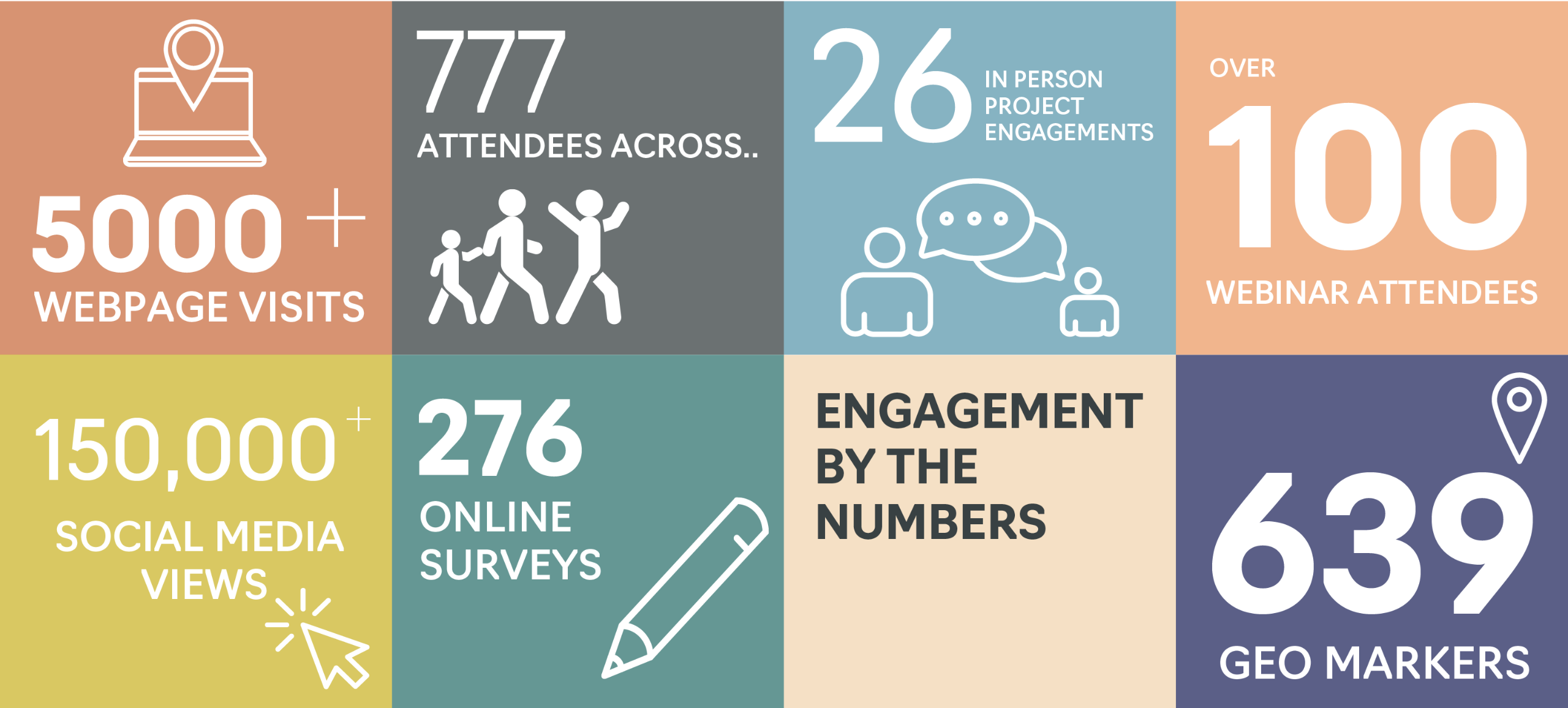
We would like to extend a sincere thank you to everyone who took part in our community engagement - especially the 276 people who completed our online survey and the 777 individuals who connected with us at in-person events across the region. We also want to thank those stakeholders, community groups, schools and surf life-saving clubs who supported our engagement.
The graphic below provides a visual representation of where we engaged with people, both online and in-person, within our region and beyond, at Stage 2, noting we will build upon this in future stages. It is inclusive of 26 in-person engagement sessions, of which 10 were community workshops, 7 were community events/markets and the remainder were place based engagement pop-ups or coastal walk and talks. Percentages listed in the Engagement Map are of our total online (276) and in-person (777) engagement.
ENGAGEMENT MAP - ONLINE & IN PERSON
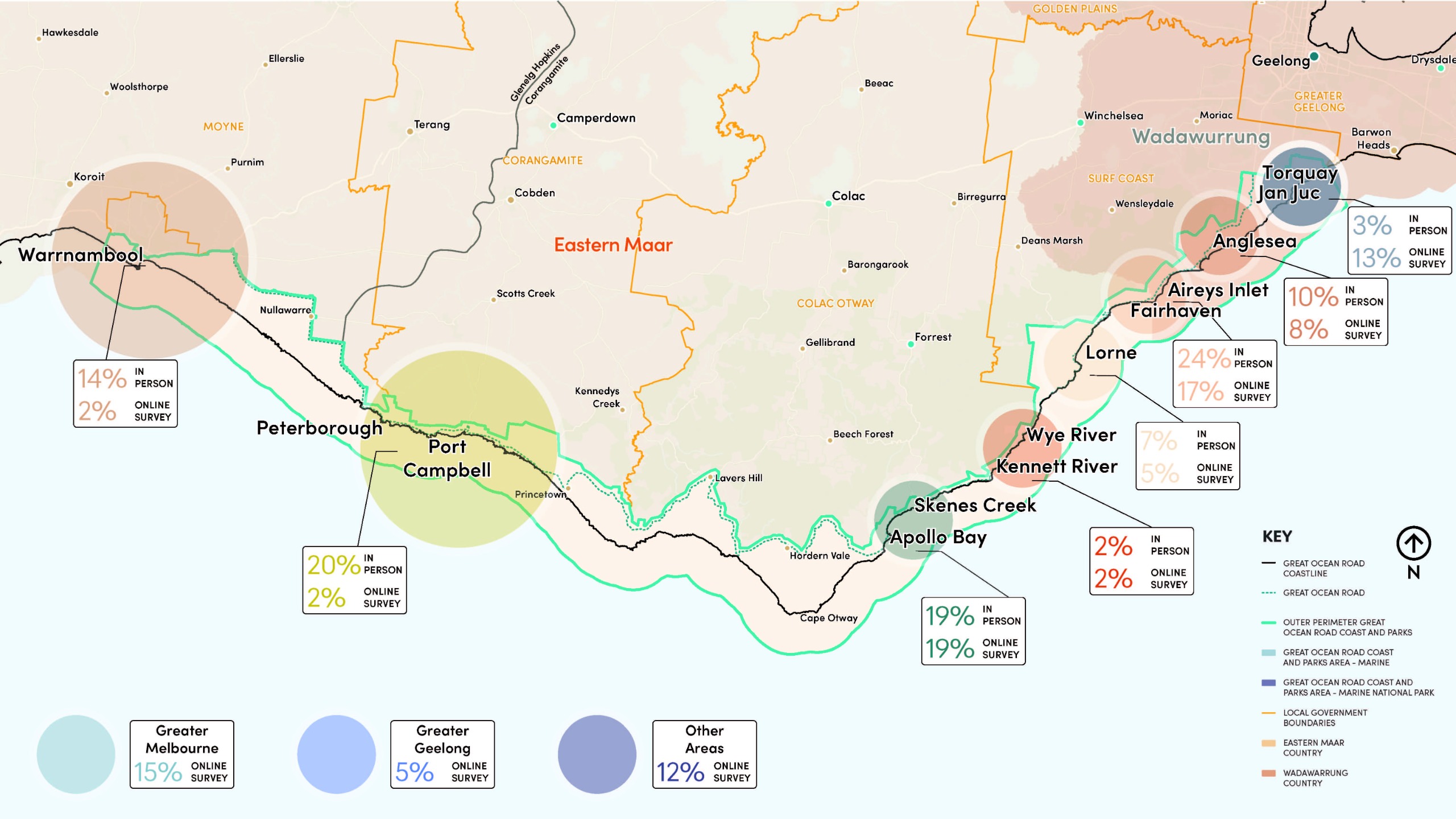
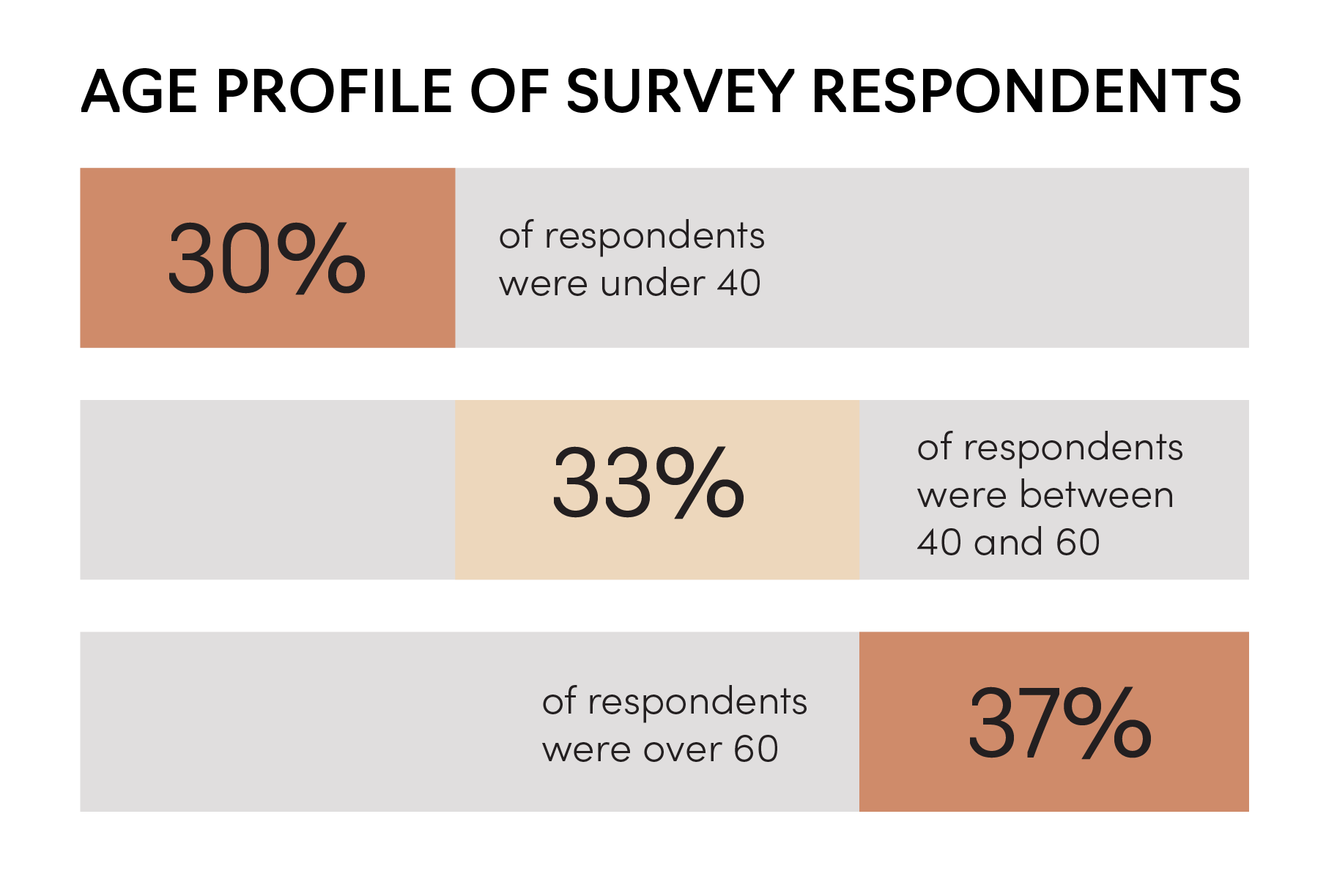 Notably, we had good uptake from our youth and young adult cohorts, across both the survey and in-person activities, attributed to partnering with Surf Life Saving Clubs, engaging with secondary schools, and using interactive tools like our wave tank and colouring-ins.
Notably, we had good uptake from our youth and young adult cohorts, across both the survey and in-person activities, attributed to partnering with Surf Life Saving Clubs, engaging with secondary schools, and using interactive tools like our wave tank and colouring-ins.
As shown in the diagram below we also had an even spread across our age groups with 30% of our survey respondents were aged under 40, 33% aged 40-60 and 37% aged 60+.
We heard from those who have a strong relationship with the coast with 82% reported visiting the coast at least weekly (including 31% daily and 33% multiple times per week) and 73% live on or near the coast.
Section 1 - WHAT WE HEARD Values & Connection
The Great Ocean Road coast is enjoyed by so many in so many different ways. We heard that the coast holds a special place in the hearts of many. A high value is placed on its unique blend of natural beauty, recreational opportunities, caring coastal communities and an intimate connection to the natural world.
For many, their connection to the coast goes back generations and today the coast remains a cherished part of your daily lives, and you see the changes to the coast with every tide, season and weather event.
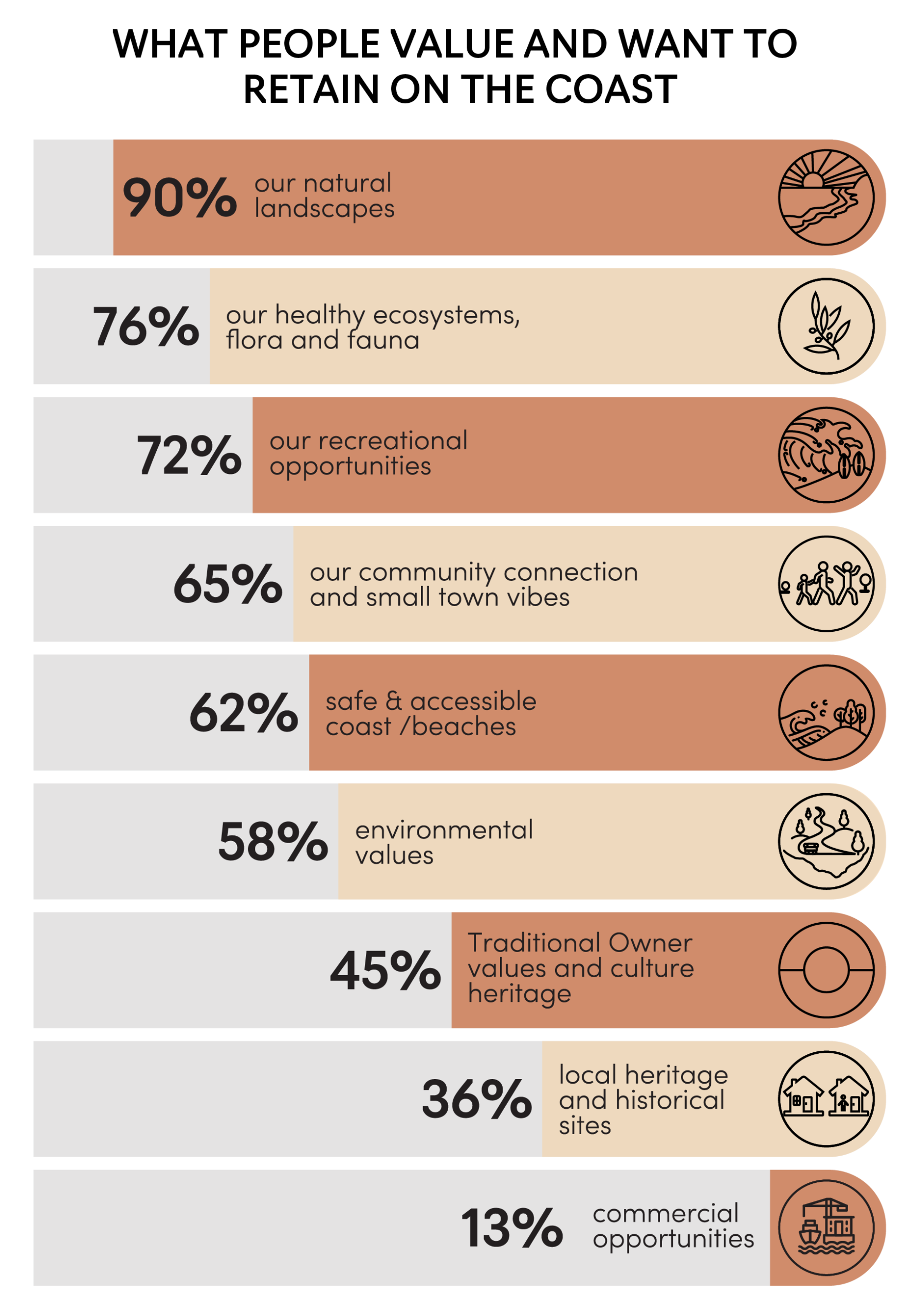
Natural landscape
Throughout our online and in-person engagement we heard the coast is highly valued for its stunning vistas, from rugged cliffs to expansive sandy beaches, coastal heathland and rainforest, and marine sanctuaries. That it is home to diverse flora and fauna, all offering a visual feast that changes with the seasons for resident, holiday maker or visitor alike.
“There is nothing like it in the world, it is one of the most unique and spectacular landscapes in Australia with unique wildlife and significant cultural values.” - A person living close to Port Campbell.
Healthy Eco-systems
We also heard that the region’s unique blend of terrestrial and marine environments, including the vital ecological corridor provided by parks, reserves and crown land on the ocean side of the Great Ocean Road, are teeming with biodiversity, and are highly valued and extremely fragile, hence in need of our protection.
“It is a naturally beautiful place that supports a vulnerable ecosystem; it is incredibly unique and something that must be protected...” - An Aireys Inlet local
Recreational Opportunities
Recreation along the Great Ocean Road is deeply cherished, offering both locals and visitors a profound connection to nature and a chance to unwind in one of Australia’s most breathtaking coastal settings.
The coast supports a wide range of activities such as surfing, swimming, fishing, snorkeling, and paragliding, catering to adventure seekers and families alike. We heard the coast serves as a place for meditation and relaxation as well as a gathering place for families and friends.
‘Whether you are paragliding or sky sailing, swimming, surfing, dog walking, hiking, boating - this is paradise we live in and nowhere else comes close to the surf coast, we are blessed to live here.” - A Torquay resident
Community Connection
We heard people love living in and visiting the different towns and communities along the coast, each with their own vibe, history and unique story. People value the connection to place and appreciate what being a part of a small coastal community brings to their lives.
“I love the small town community feel.” – An Aireys Inlet resident.
Safety and Accessibility
Safety and accessibility was raised often with people telling us how they loved some of the more protected and accessible parts of the coast, but also how we need to do better in terms of cliff safety education, traffic management, parking, safe and accessible beach access for all abilities and all age groups.
“I would like the coast to be healthy, accessible and able to be enjoyed by all.” – A Tower Hill resident.
Environmental Values
We heard that we all have a responsibility to protect the coast's natural beauty, with those we spoke to advocating for sustainable management practices, increased conservation efforts and strong desire to keep the coast as natural as possible.
“The coast is special to me because we’re surfers and adamant about protecting the natural environment, our coastline, and our marine life.” – A Deans Marsh resident.
Traditional Owner Values and Culture Heritage
We heard that cultural heritage and Traditional Owner values are an important part of the historical, current day and future management of the coast, with the need to further guided by Aboriginal knowledge and practices.
“In fifty years time I would like the coast to be a place where people know the traditional stories and culture of it, in order to connect with and care for it.” – A Fairhaven resident.
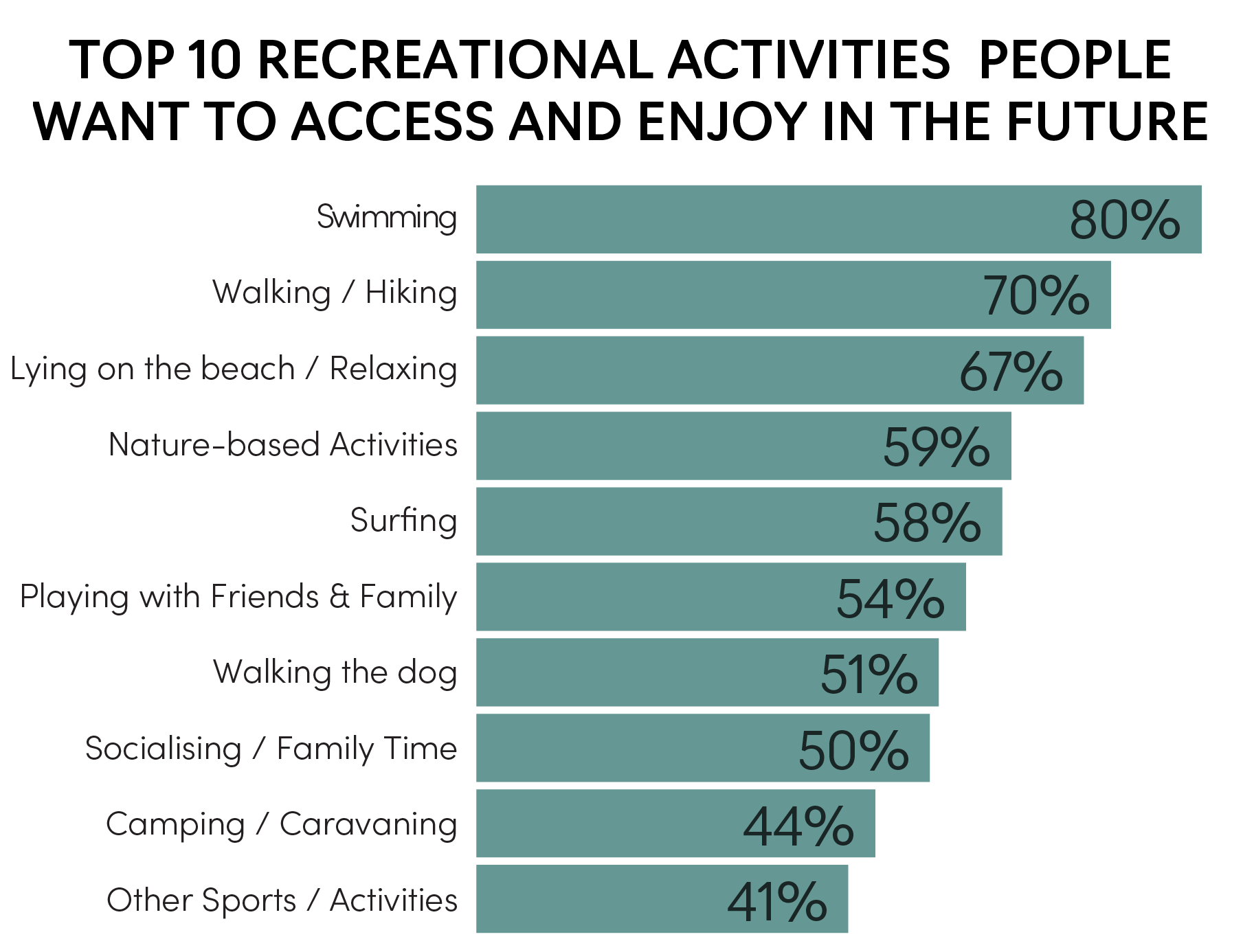
Future Recreational Use
To better understand how people would want to recreate on the coast into the future we asked our survey respondents to tell us what they wanted to be doing on the coast in twenty years time in terms to recreation?
As shown in the graph, over half of all respondents told us they want to be swimming (80%), walking/hiking (70), relaxing on the beach (67%), doing nature-based activities (59%), surfing (58%), playing with friends/family (54%) or walking the dog (51%) on the coast in twenty years’ time.
We also heard from a large number of paragliders and kiteboards who highly value the coast and their connection to it.
Although we didn’t include these activities as
options in this specific question, which was based of previous studies, we will
include these options in future surveys and very much appreciate the input and
feedback.
Section 2 - WHAT WE HEARD Knowledge & Concern
Our communities right along the coast are full of people who care for the coast and who have a high level of awareness of the impacts climate change and other forces are having on this unique landscape.
Unsurprisingly, we recorded a very high level of understanding in relation to drivers of change and impact of coastal hazards from those who engaged with us online or in-person. More than 80% of those who completed our survey were able to provide examples of where they had witnessed the impact of coastal hazards along the coast within the last twelve months.
With this high level of knowledge also came a high level of concern for our coast, and also a willingness to work together to plan for coastal adaptation along our coast line and within our coastal communities .
“We are smart people. We can work together to solve these issues.” – A Wye River local
As shown in the graph below 3 out of every 4 survey respondents agreed that further work is required to prepare for future coastal hazards. They also told us they want to mitigate risks and protect key values or assets along the coast relating to infrastructure, access, amenity, the natural landscape and environment.
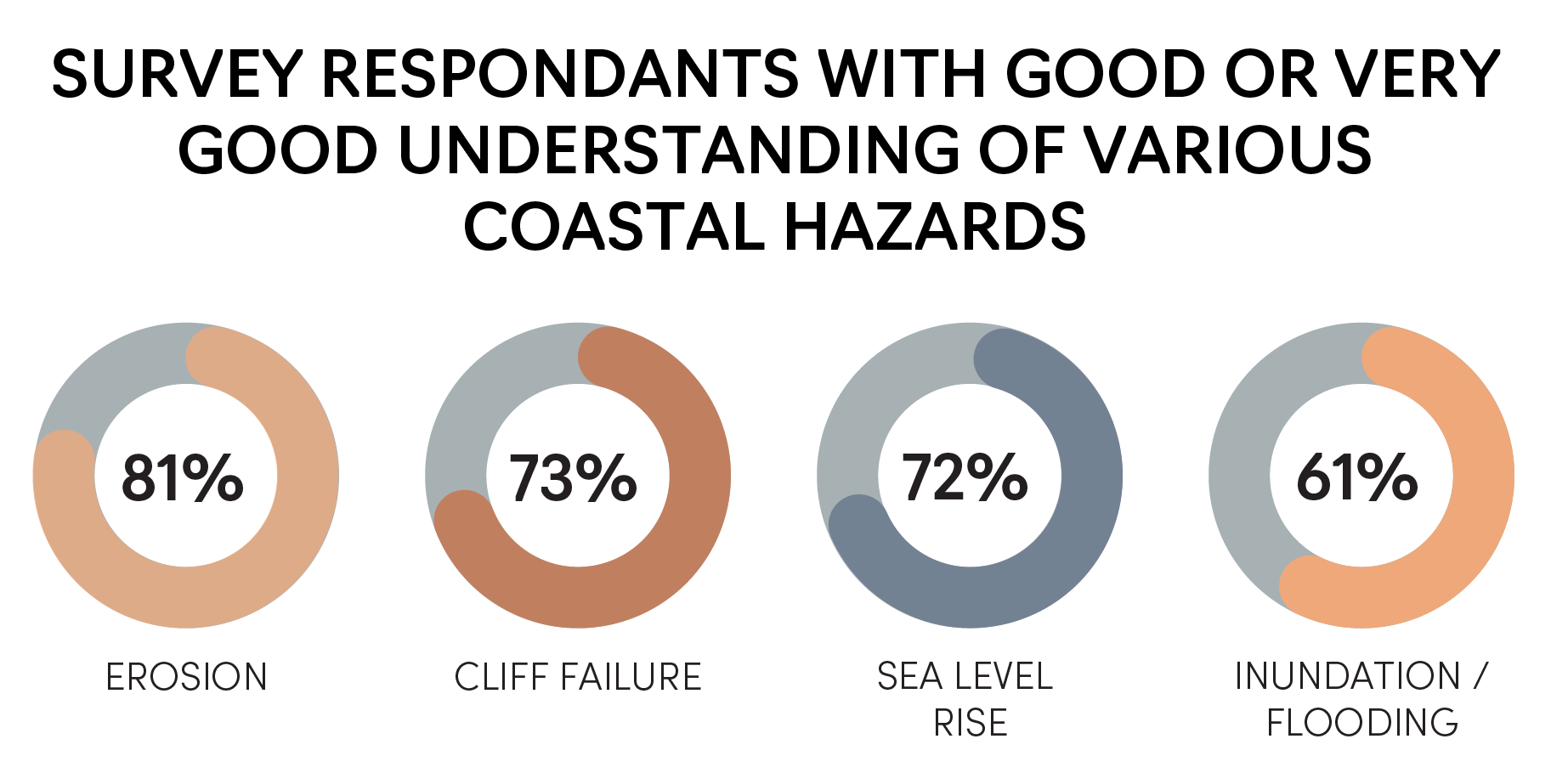
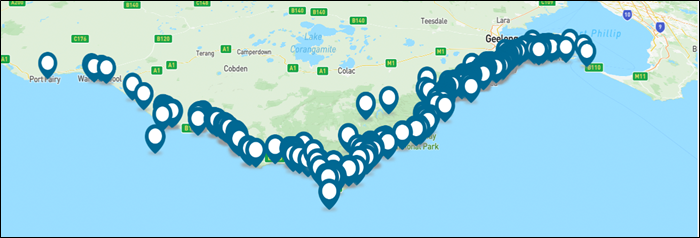
Whilst the Regional Coast Adaptation Plan is a long-term strategic approach to coastal hazard management, we also captured a significant amount of information on immediate needs for coastal adaptation at key sites in the region. Many community members were clear they do not want to wait to see action to address the impact of coastal hazards.
“If we're to protect our coastlines, we need drastic and immediate action. The time has passed for kicking the can down the road.” - An Apollo Bay resident.
Key coastal adaptation projects are currently underway throughout the Great Ocean Road region, and information captured throughout our Regional Coastal Adaptation Plan development will help inform and enhance these site-specific works.
The information we captured in this stage (Stage 2) about how particular coastal hazards have been impacting specific sites along the coast, as well as concern for future coastal hazard impact, will be further unpacked and incorporated at Stage 3 of the project when we map coastal hazard exposure.
As per the scope of this project, the main coastal hazards we sought input on were erosion, inundation/flooding, cliff failure and sea level rise, which as shown in the graphic below the majority of survey respondents believe will have an impact our coast over the next 50 years.
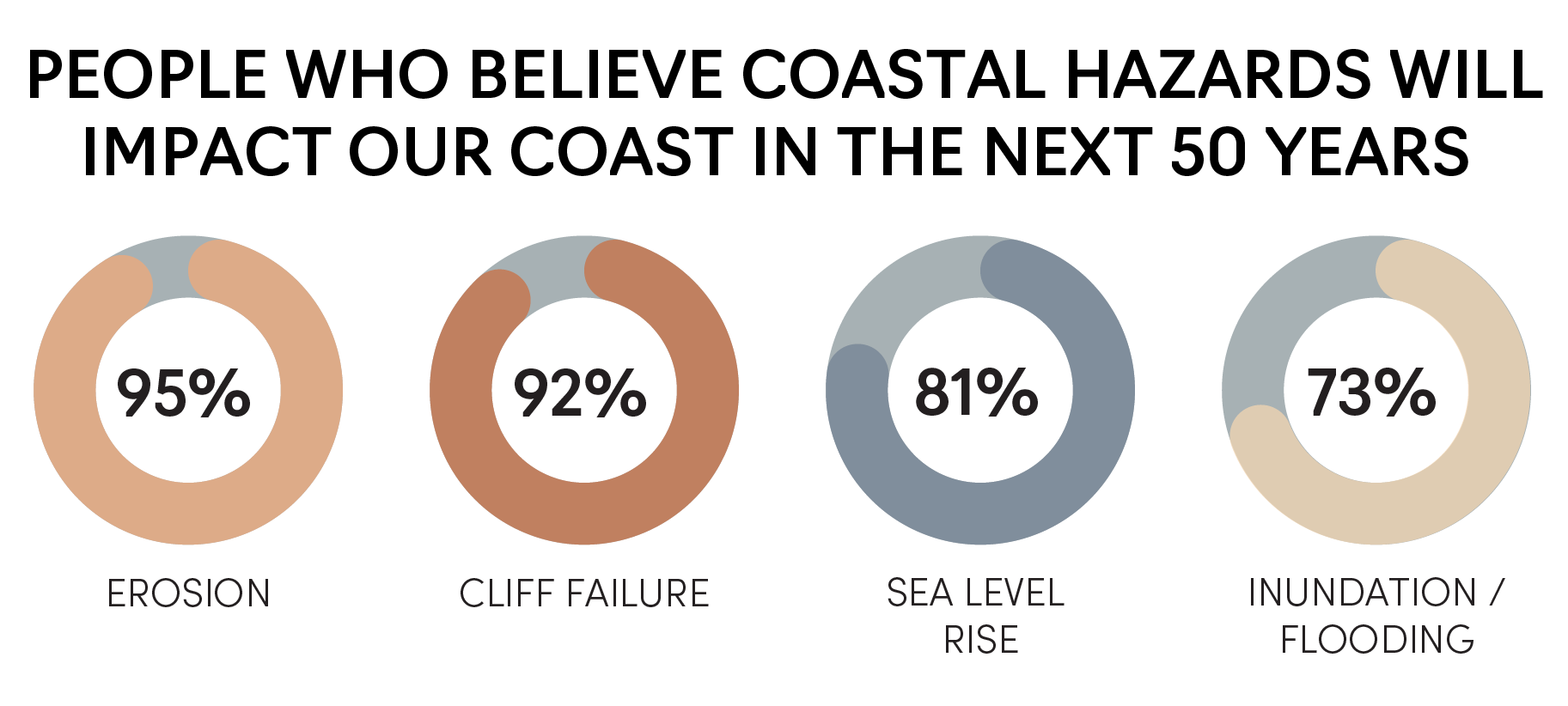
Below is a snapshot of what we heard about each of the main coastal hazards, as per the project scope.
Erosion: Survey respondents widely reported beach and dune erosion along the Great Ocean Road coastline, with significant sand loss observed at multiple locations. The most frequently mentioned beaches were Fairhaven, Point Roadknight, Torquay, Apollo Bay and Marengo.
We heard sand loss is seasonal and a part of a natural process and cycle. However, it was also noted that there has been significant sand loss along the coast due to high tides, storms surges and recent extreme weather events, leading to rockier shorelines, hazardous swimming conditions, reduced access, increased cliff failure and dune loss. Many community members are worried about the long-term environmental impact of coastal erosion, from coastal processes and human impact, and questioned the effectiveness of current management strategies.
Cliff failure: Cliff failure, and the threat it poses to public safety and community infrastructure, was highlighted as a coastal hazard of high concern. We heard that cliffs in areas such as Demons Bluff, Point Roadknight, Southside, Jarosite and Gibsons Steps are being undermined by high tides, increased wave action and extreme weather events, leading to continued collapses along our coast.
We heard locals and visitors alike want to maintain access to these sections of the coast. There is also considerable concern for public safety, scepticism around the effectiveness of signage and a desire for better protection of cliffs in our most visited beaches, with some suggesting placing rock at the bottom/toe of the cliffs.
Sea level rise: We heard that whilst people have yet to witness or experience any significant impacts from sea level rise, there are moderate levels of trepidation and uncertainty in relation to what the impact of sea level rise could be along the coast.
People are eager to clearly understand what the potential impacts will be, in what timeframe and what we plan to do to mitigate these impacts.
Coastal inundation/flooding: We heard the impacts of inundation are being felt along the coast, especially in areas with estuaries and waterways. Areas of flooding concern include the Aire River, Gellibrand River, Curdies River, Wye River, Painkalac Creek and Anglesea River. Respondents expect flooding to become more common and more severe along the coast.
There is concern that increased high tides, wave action, storm surges and severe weather events will lead to more road closures, road access issues, damage to community infrastructure and private property. Concerns are also held in relation to negative environmental impacts including the further decline of river health and estuary dynamics.
Section 3 - WHAT WE HEARD Issues & Opportunities
Throughout our engagement, we heard a mix of concerns, criticisms, constructive suggestions and optimism regarding coastal hazards, adaptation and the management of the coast.
At the top of people’s lists was the need to better manage our coast now, as well as planning for the future, with the impacts of climate change and coastal hazards already felt along the Great Ocean Road coastline.
“Coastal erosion is visible and the management of these risks is entirely necessary”. - A Torquay resident
“…We now have a deep and profound opportunity to move towards a sustainable and adaptive way of living on our coasts…”. - A frequent visitor to the shore of Aireys Inlet
“There are hazards all along the coast. The key is to accept them and work with the changing landscape.” - A Jan Juc Resident

There were also strong calls for investment in the following areas:
- Improved, fit for purpose and environmentally sensitive infrastructure upgrades, ranging from basic amenities (toilets, showers, carparking etc.), to viewing platforms, visitor centres, recreation facilities, boat ramps and beach access.
“At the risk of stating the obvious just get the car parks, toilets, showers right…We need decent facilities… The whole coast needs millions spent on it if it is going to be the “great” ocean road, right now it’s all cheap, shabby and dilapidated.” – A Surf Coast resident.
“No architectural designed viewing platforms or destruction of local towns.” – Port Campbell Resident
- More sustainable tourism practices including a more regenerative model that enhances community and environmental values and doesn’t strain aging infrastructure or negatively impact our coastal environment and communities.
“I think the hazard of over tourism needs to be managed - tourists are essential to the towns and we want to share this amazing space but it needs to be much better managed.” - An Aireys Inlet resident.
“Charge tourists a gold coin amount to park and visit the 12 apostles to pay parks officers so we can have more of them preserve the environment.”- A Corangamite Shire resident.

- Transparent decision making and timely action to address the impacts of coastal hazards on our most visited and valued beaches along the Great Ocean Road.
“Marengo beach will need addressing before it washes out the Great Ocean Road.. [and] action needs to be timely, not too much debating or it becomes too complex. Someone at some point needs to make a decision. Community input is good but move quickly on the best solutions.” – A Marengo resident
- Faster remediation to damaged infrastructure on our coast, including seawalls and beach access.
“Seawall at Cosy Corner and Front Beach Torquay… GORCAPA not acting quick enough when problems first arose caused more damage to be done than it should have.” – A Surf Coast local.
“Fix the sea wall. Fix the steps at Juc. Fix the ramp at Torquay.…” – A Torquay resident.
“Potential damage to Fairhaven surf life saving club from sand erosion however no one is fixing or doing anything about it!!”- A Fairhaven Surf Life Saving Club Member

- Protecting community infrastructure including surf life saving clubs, angling clubs and the Great Ocean Road.
“The erosion along the coast … the future of the surf club and the potential for the great ocean road at Eastern view to be impacted.” – A frequent visitor to Eastern View.
"Storm surges damaging roads and beach access near middle island in Warrnambool." – A Warrnambool local.
"Roads are getting much closer to the sea, in danger of collapse." – A Lorne holiday homeowner.
“We have seen the beach wash away sand dunes, stairs, cliffs and erosion the base of the Fairhaven surf club.” – A Fairhaven local.
"Lack of erosion control at Point Roadknight especially at boat ramp, the car park access/yacht club will soon be impacted due to severe erosion…”– A Point Roadknight resident.
- Environmental conservation and preservation of a natural coastline, with the need to find a balance between investing in required infrastructure upgrades and the desire for keeping the coast as underdeveloped and as natural as possible.
“We come to the coast to look at the natural beauty… Do not let the Princetown wetlands be developed, preserve native flora and fauna.” – A Princetown local.
“I am concerned with some of the development I have seen around our coastline. I believe a less is more approach, regard for locals that live there and above all else maintaining the pristine ecosystem should be prioritised.” – A Port Campbell resident.
- Care for Country and sites of Aboriginal cultural significance in accordance with Rights Holders.
“Pre European settlement aboriginal middens now being washed away by rising sea levels and increasing severe storm surges. More research locating, understanding, protecting and monitoring these middens.” – A Colac Otway Shire resident.
- Improving access along our coast for young families, the elderly and for people with a disability, including improved beach access points, walking paths, signage and community education to ensure our coastline is safe and accessible for everyone now and into the future.
“Better access for people with disabilities at all beaches along the coast… it is a right for these people to have access…” – An Anglesea local.
" More time/money needs to go towards better construction of tracks and stairways to help them withstand the natural elements better than previously." – A Fairhaven local
“It is essential that existing tracks, access steps etc are well maintained… to make it safe and accessible for prams, mobility devices and generally safer for people to walk along.” – An Aireys Inlet resident.
- Improved estuary management and prioritisation of river health right along the coast as they continue to experience the impacts of climate change and human intervention.
“Estuary openings don’t allow for a natural flow… just a balls up the whole thing… for such an important brilliant waterway”. – A Princetown local.

- Greater protection of fragile ecosystems and environmental values from the impacts of coastal hazards, climate change and human impact.
“I'd love to see natural habitats with room to retreat and innovative solutions to preserving the unique values of the coast that aren't environmentally damaging or visually destructive.” – A frequent visitor to Anglesea.
- Increased education and awareness campaigns promoting cliff safety, protection of our dunes, flora and fauna. Noting there were also many respondents who thought signage alone is relatively ineffective.
“Erosion of sand dunes due to people walking through and disturbing vegetation. More education needed. Such a pity you closed your education unit… More education needed.” - An Aireys Inlet resident.
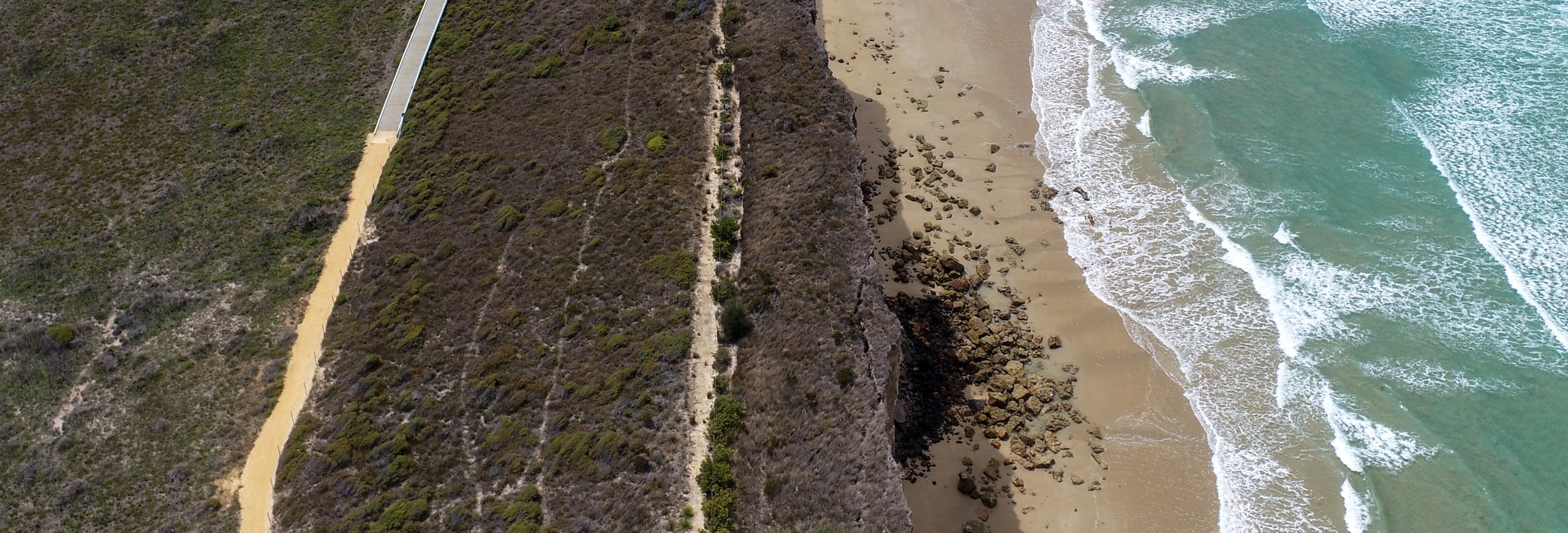
Questions were raised regarding the Great Ocean Road Coast and Parks Authority’s capacity to respond to coastal erosion events, alongside calls for greater transparency, accountability, and on the ground action from us as the land manager.
A Lorne resident told us, “GORCAPA is negligent and inefficient. The gradual erosion of services to our foreshore is deplorable!!!”.
Whilst an Apollo Bay resident said, “All work done by GORCAPA has done nothing to help ease any hazards. Mothers Beach in Apollo Bay is a classic example.”
There were also those who appreciated the work the Great Ocean Road Coast and Parks Authority are doing.
An Anglesea resident told us, “I think that overall coastal management is being done well. Greater integration of various groups would help locals to navigate the complex authorities and responsibilities.”
A Fairhaven resident said, “I look forward to working with GORCAPA to enhance the natural environment for the benefit or us all.”
Section 4 - WHAT WE HEARD Community Aspirations
A key component of our community engagement at Stage 2 of the Regional Coastal Adaptation Planning project was to capture how those who love our coast want the coast to be in future.
To aid us in capturing the aspirations for our future coast we asked our survey respondents and those we spoke to in person to tell us in fifty years’ time how would they like the coast to be?
Responses to this question reflect a strong desire to preserve its natural beauty, recreational use, access for all and environmental integrity. People want the coast to remain largely unchanged, with minimal development and a focus on preservation, sustainability and connection.
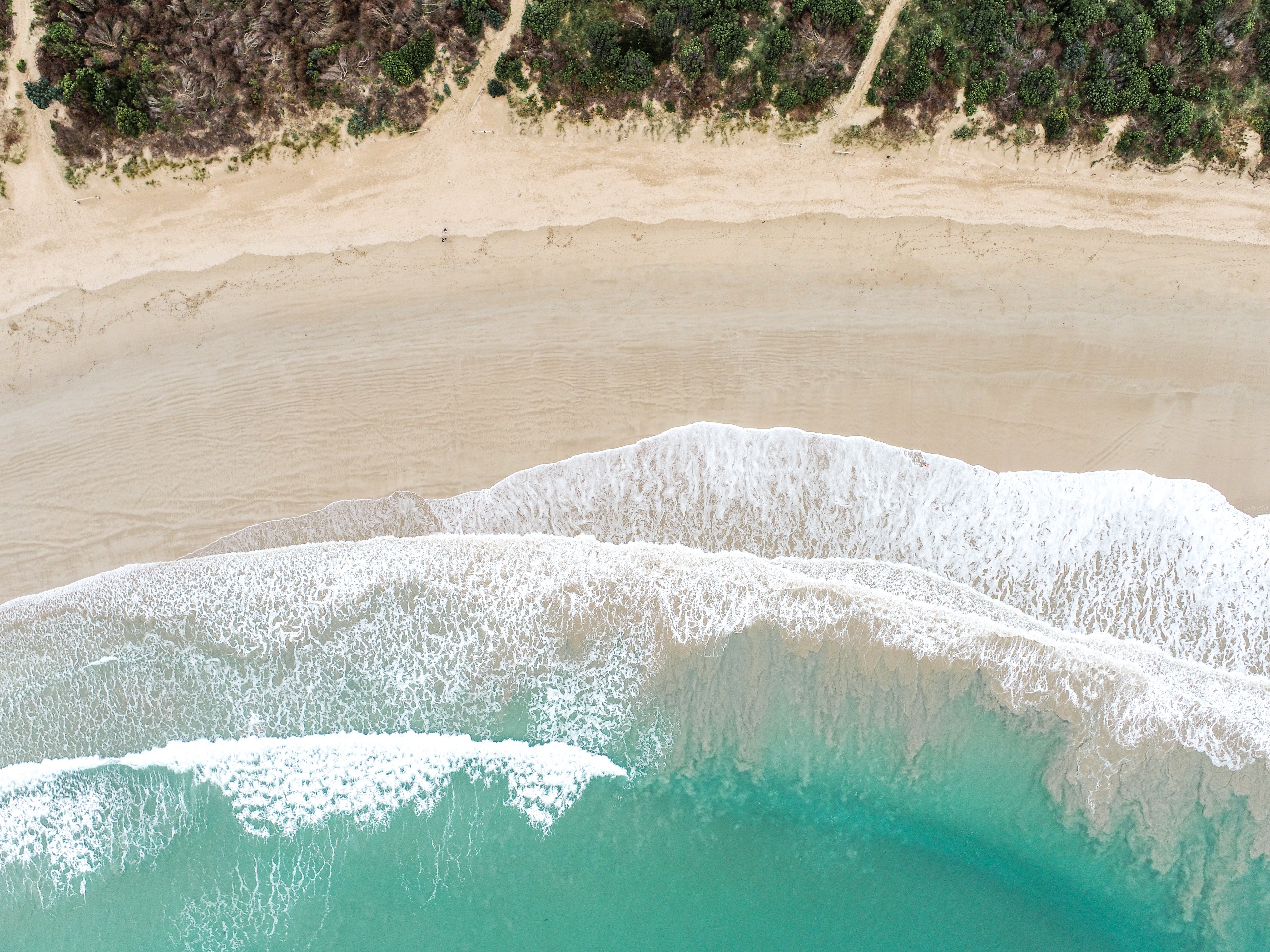 Key themes regarding aspirations for our future coast were:
Key themes regarding aspirations for our future coast were:
- Keep our future coast as close as possible to how it is today.
“As it is today, well balanced between focus on use and environment.” – A Torquay resident.
“As good or in better condition than today.”– A Kennett River local.
“The same.” or “As it is now.” or “Still here.” – Multiple respondents.
- A healthy, clean and natural environment for wildlife and humans to enjoy.
“Clean and healthy (even in tourist season). I would like the coast to have great waves for surfing. accessible for everybody… a great habitat for animals to live a healthy life.” – An Apollo Bay resident.
“Not eroded, not polluted, has lots of native wildlife around, rubbish free.” – An Apollo Bay resident.
“A pristine ecosystem and desirable place to live and for families to grow together.” – A holiday homeowner on the Surf Coast.
“A healthy, thriving, biodiverse ecosystem with clean water and beaches and healthy natural landscapes, with ways for the community to connect with the coast, in a way that respects the environment and the aboriginal cultural heritage.” – An Apollo Bay resident.
- Underdeveloped and not overcrowded.
“As untouched as it is now with better wildlife and native planting management. We need to ensure no further beaches are lost to break walls.” –A Lorne resident.
“At this current or lesser level of development, kept as natural as possible, having a smaller coastal community feel.” – A frequent visitor to the Surf Coast from Melbourne.
“International tourism is not prioritised over local needs. Current surf breaks are not ruined by coastal engineering projects.” – A Colac Otway Shire resident.
“Treasured and preserved so that the wildlife and habitat is protected. All development should respect the environment and communities should not be overcrowded with visitors and traffic.” – An Aireys Inlet resident.
- Improved accessibility and continued recreational use.
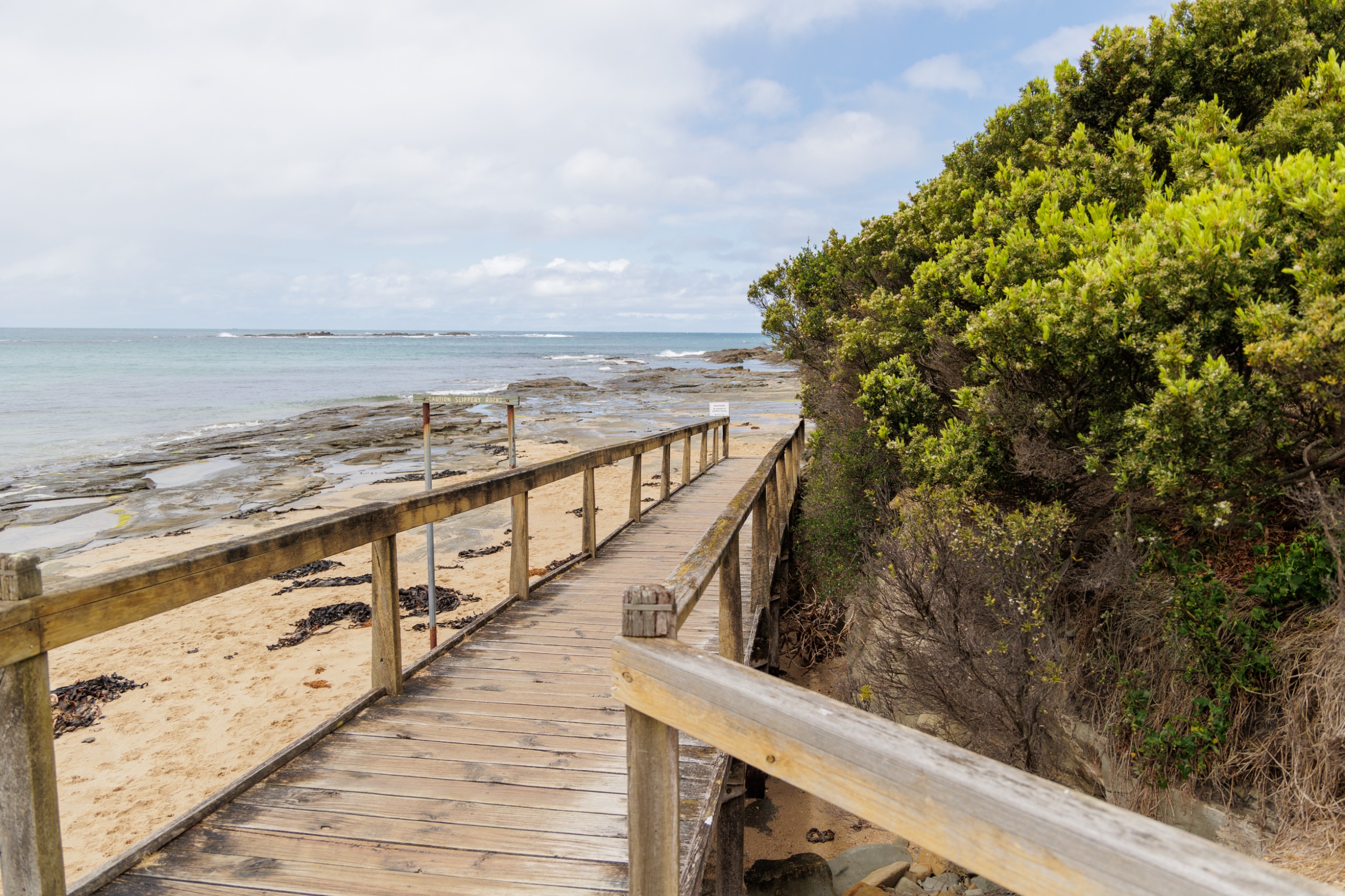
Accessible for all to enjoy, whilst maintaining a peaceful vibe and with a healthy ecosystem. – A Warrnambool resident.
“Able to be used by all in the choices of their work rest or pleasure.” – A Warrnambool resident.
“Available to everyone, whether a local or tourist with little interference from bureaucracy.” – An Anglesea resident.
“A healthy and resilient interface between the land and sea where nature and people thrive and coexist together.” – A Barwon Heads resident.
Draft Vision Statement
The insights and information gathered through our community engagement at Stage 2 will lead the development of a shared vision and objectives for coastal hazard risk management and adaptation.
The draft vision statement below, along with a set of objectives, will continue to be developed and refined with input from key stakeholders and community via our Have Your Say page. Once finalised it will be published in the RCAP Stage 2 Summary Report and on the Have Your Say webpage.
Regional Coastal Adaptation Plan for the Great Ocean Road region – Draft Vision Statement:
Section 5 - WHAT WE HEARD Feedback on Engagement
A feature of our Looking Forward in-person engagement was the design and use of our Resilient Coast Engagement Trailer, wave simulation tank and associated activities including a ping-pong quick poll, wildlife exhibit and kids colouring-in station. These resources received positive feedback and were effective in providing interactive experiences for our community members, particularly the younger cohort.
Our 10 targeted community workshops and four ‘Walk and Talks’ fostered rich, in-depth discussions and meaningful exchange. Although they only averaged 10 participants each, the smaller size allowed for strong community representation from the locals who did attend appreciating the opportunity to contribute thoughtful and place-based insights.
Our online engagement featured a series of short informative videos that were developed and used to both engage people online via our Have Your Say page and boosted social media posts. These videos receive high view rates and resulted in increased traffic to our website.
An Anglesea resident had this feedback for us, which we will look to incorporate in future engagement for this project, “It would be great to be able to better visualise what impact different climate scenarios might have on our coastline.” – An Anglesea resident.
ur survey received an average of a three and a half star rating (out of five) and we were provided with a range of feedback from our survey respondents:
ONE STAR * “Why are you asking about managing for climate change when you can’t even manage the current level of tourism and the rubbish that it brings?” – An Airey Inlet resident.
TWO STARS ** “Stop wasting money on surveys and drop-in meetings, actually do something beneficial for a change.” – A Timboon resident.
TWO STARS **“You direct peoples answers too strongly. You believe that you are the experts and that the public are sheep.” – A Fairhaven resident.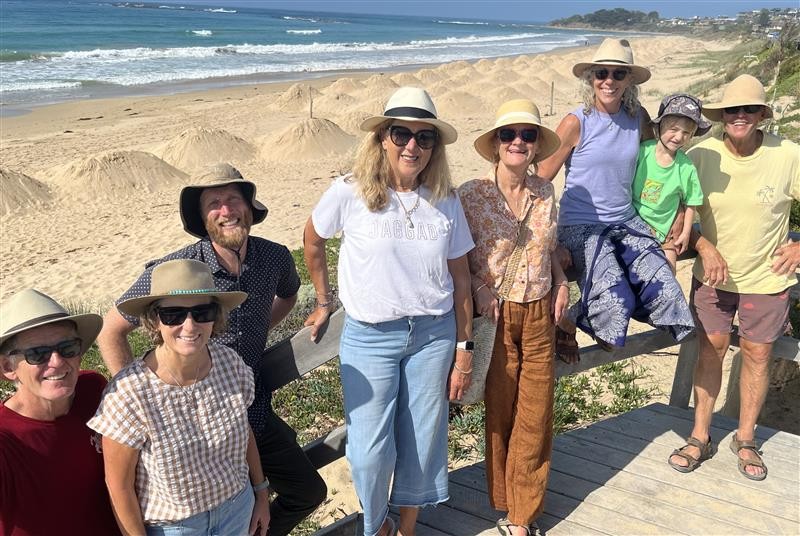
THREE STARS *** “I feel the survey is very superficial. It is such a complex ask that I understand that it is not easy but this feels a bit like box ticking.” – An Airey Inlet resident.
FOUR STARS**** “Please continue consultation with people who live or holiday in the coastal area.” – A Point Roadknight holiday homeowner.
FOUR STARS **** “Thank you for the opportunity to comment on the future of this unique and beautiful coastline.” – A Surf Coast resident.
FIVE STARS *****“You guys are doing a great job on a limited budget and staffing but could possibly do better in getting your messaging across using traditional and social media.” – A Marengo resident.
FIVE STARS *****“I think GORCAPA is doing an excellent job. Keep up the great work.” – A Fairhaven resident.
Thank you to everyone who engaged with us and who supported our community engagement at Stage 2!
Section 6 - Next Steps
Stage 3 – Coastal Hazard Data Gathering
As we progress to Stage 3 of this project, local knowledge and values captured at Stage 2 will provide a foundation for confirming coastal processes, mapping coastal hazard exposure and gathering the best available data at Stage 3 so it can be used at Stage 4 to accurately identify and map coastal hazard vulnerability and risk, right along the coast.
We anticipate Stage 3 of the Regional Coastal Adaptation Project will commence in late 2025 and conclude by mid-2026 with Stage 4 to follow.
Continued Community Engagement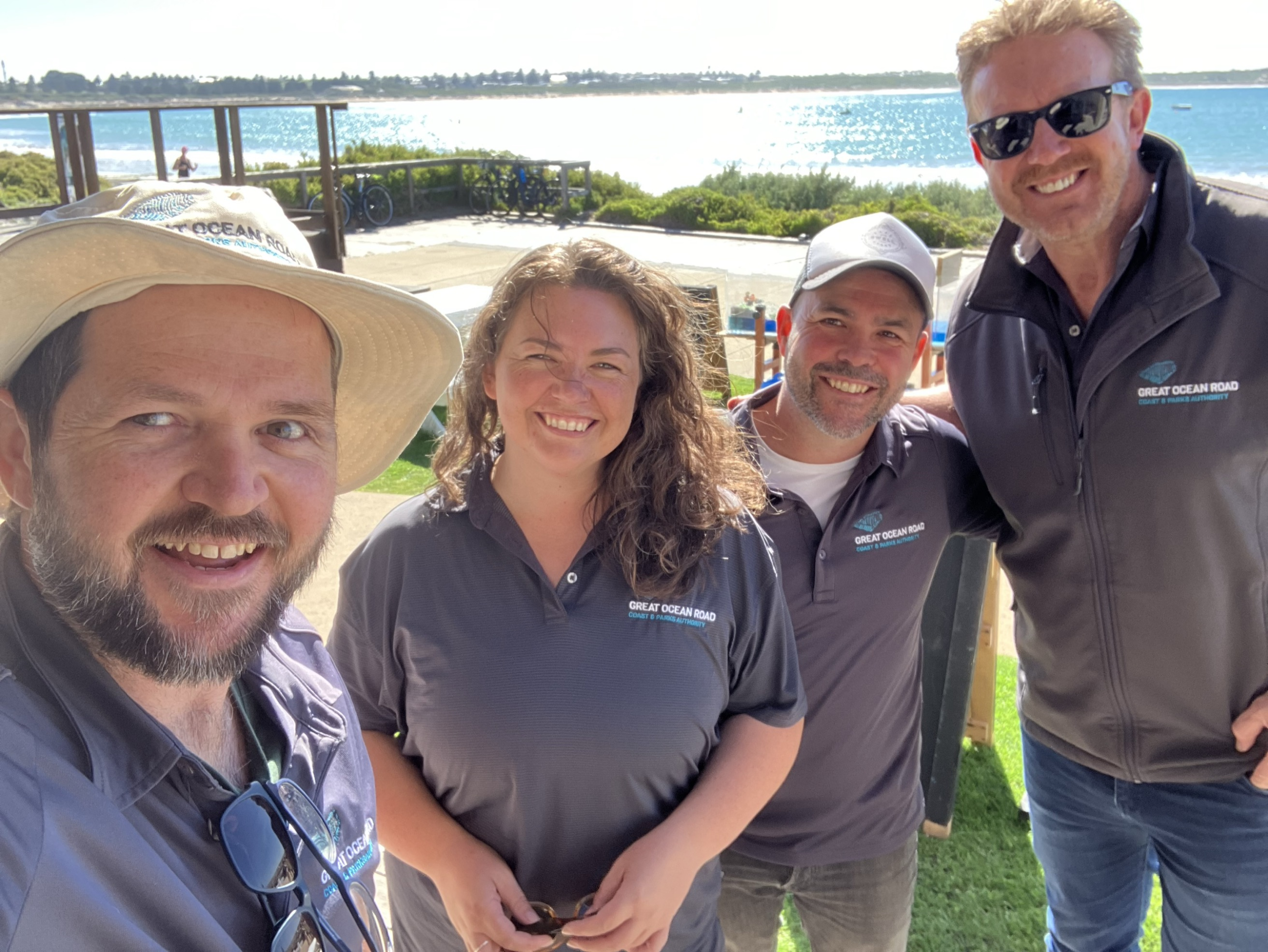
Community engagement will take place at every stage of the Regional Coastal Adaptation Planning Project. We will continue working with everyone who loves this coast, including key stakeholders and Traditional Owners. At Stage 3 we will work to develop a shared understanding of coastal hazards and draw on local knowledge to validate and refine hazard data and information.
This approach will help ensure that current and future decision-making on coastal hazard risk management and adaptation is evidence informed and utilises the best information available including local knowledge and place-based modelling.
Stay Engaged
Click on the +Follow button on our Looking Forward – Have Your Say page to receive updates
when we release our Stage 2 Summary Report and launch our community engagement for Stage 3.
Alternatively, you can also email us at: haveyoursay@greatoceanroadauthority.vic.gov.au
For more information on coastal adaptation planning along this iconic coastline please watch the video below.
Feedback
Contact Us
For enquiries relating to Looking Forward and the Regional Coastal Adaptation Planning project please include Looking Forward in the subject line of your email.
| Name | Jane Shearer (Project Manager) Andy Bell (Community Engagement Coordinator) |
|---|---|
| Phone | 1300736533 |
| haveyoursay@greatoceanroadauthority.vic.gov.au |


